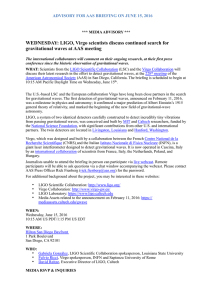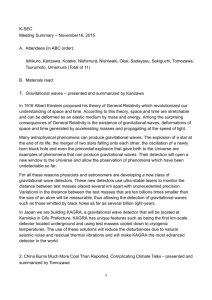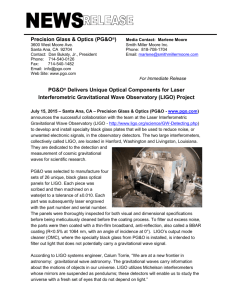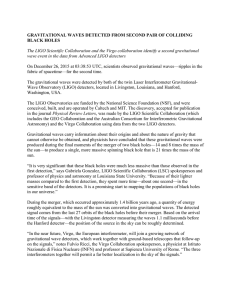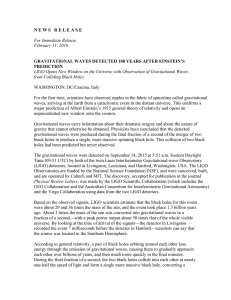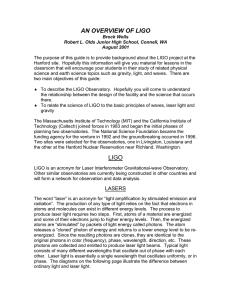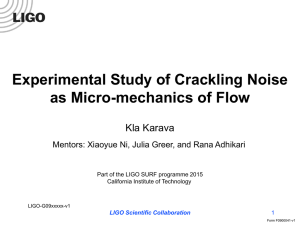-- Gravitational Waves -- Sources and rates for LIGO Hsinjung Lin Class presentation
advertisement
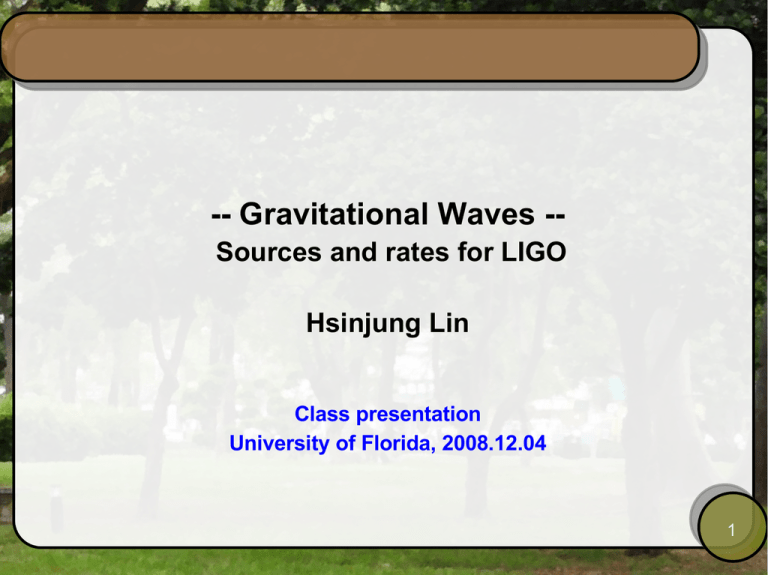
-- Gravitational Waves -Sources and rates for LIGO Hsinjung Lin Class presentation University of Florida, 2008.12.04 1 Outline Gravitational waves Quadrupole approximation Amplitude Frequency Polarization Sources of gravitational waves for LIGO What is LIGO and how does it work Constraints and sensitivity curve Sources 2 Gravitational Waves Accelerating objects with non-spherical symmetric motions cause ripples in the curvature of spacetime. The energy of the changing field propagates outward at the speed of light. 3 Gravitational Waves Quadrupole approximation Lowest order of the post-Newtonian approximation Gives the first approximation to the radiation emitted by a weakly relativistic system Quadrupole moment tensor I ij t=∫ y y T 00 t , y d y i j 3 Quadrupole formula 2 d I ij 2G hij t , x = t r 2 r dt 4 Gravitational Waves Amplitude The motion inside the source is highly non-spherical 2Mv h≈ r 2 N.S. where v N.S. is the non- spherical part velocity and r is the distance between observer and source. Binary system – using Newtonian approximation R2S h≈ rR where 2 GM RS= 2 c is the Schwarzschild radius For a binary black hole system with both M ≈10 solar mass , R≈105 m and r≈10 24 m , the h is about 10−21 5 Gravitational Waves Frequency -- Decided by mass M and radius R 1 to 10^4 Hz for ground based detectors. 6 Gravitational Waves Polarization for a plane wave in TT- gauge (transverse traceless gauge), the solutions to the wave equation is h TT v =C v e ik x 0 0 C v= 0 0 0 0 h + hx hx −h + 0 0 0 0 0 0 7 What is LIGO? LIGO(Laser Interferometer Gravitational Waves Observatory) 8 Constraints for LIGO Seismic noise Thermal noise Shot noise Quantum effects gravity gradient Other effects : Instrumental noises coating noise... 9 Sources for LIGO Binary (inspiral) Systems Binary black holes (BBH) From 10M to 50M −4 From ~100Mpc to z=2 ( 1Mpc z=2×10 ) Binary neutron stars (BNS) From ~20 Mpc to ~350 Mpc From 1/30y(<1/3y) to 1/2d(<5/d) (data from LIGO-G060582-00-Z) 10 Sources for LIGO Spinning Neutron Stars Emitted GW when asymmetry Searching from Known pulsars Ellipticity From 3x10-6 to 2x10-8 11 Sources for LIGO Short duration GW transient -- less than 1 sec Supernovae Accreting /merging black holes Gamma ray burst (GRB) Other unknown sources Zwerger and Muller, 1996 Burst t~0.005 sec Simulated gravitational wave from core collapse 12 Sources for LIGO Stochastic background Cosmic background radiation and galaxy formation Random radiation described by its spectrum Big Bang Way to search : Cross correlate from different detectors From ΩGW ~3x10-6 to ~3x10-9 Low frequency spectrum Energy density 13 Thank you!! NASA/GSFC 14

